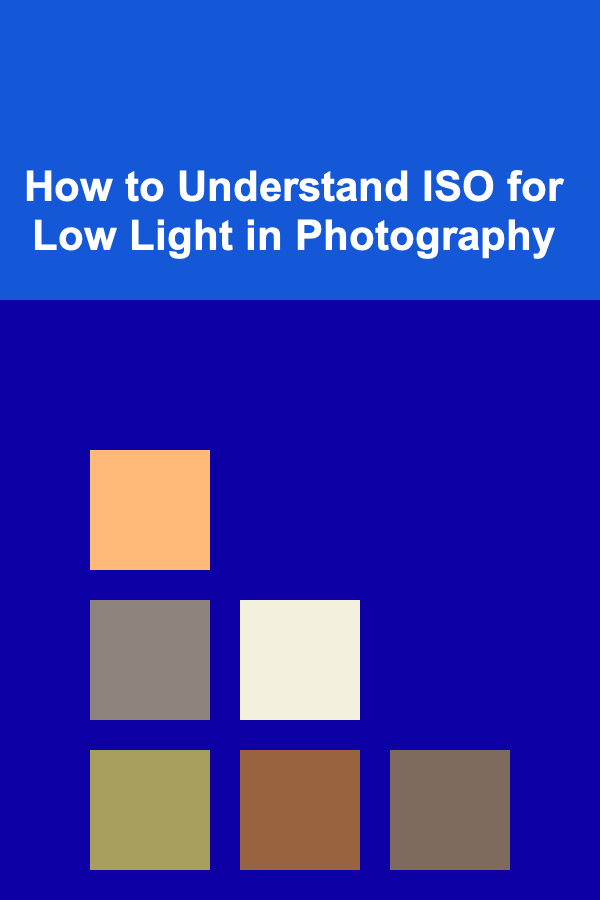
How to Understand ISO for Low Light in Photography
ebook include PDF & Audio bundle (Micro Guide)
$12.99$6.99
Limited Time Offer! Order within the next:

ISO is one of the three critical components of the exposure triangle in photography, alongside aperture and shutter speed. Understanding ISO is essential for capturing the perfect shot in various lighting conditions, particularly when shooting in low light. This article will delve into the significance of ISO in low-light photography, how it impacts your images, and how to utilize it effectively to get the best results.
What is ISO?
ISO refers to the sensitivity of your camera's image sensor to light. The term comes from the International Organization for Standardization, which set the global standards for film speed. In digital photography, it represents how sensitive the sensor is to available light. A lower ISO value means less sensitivity to light, while a higher ISO value increases the sensitivity.
In the context of low-light photography, adjusting ISO becomes crucial because it directly influences how your camera interprets light. The key challenge in low-light environments is ensuring your images are well-exposed while avoiding excess noise, grain, and loss of detail.
ISO plays a vital role in striking this balance, making it an essential tool for photographers working in dimly lit settings.
The Relationship Between ISO and Exposure
ISO is one of the three main elements of the exposure triangle, which also includes shutter speed and aperture. Together, these settings control the exposure, or the amount of light that hits the sensor, determining how bright or dark your image will be.
- Shutter Speed: Controls how long the camera's shutter remains open.
- Aperture: Refers to the size of the opening in the lens, controlling how much light enters.
- ISO: Controls the sensitivity of the sensor to light.
In low-light conditions, it's common to adjust your ISO setting to ensure enough light reaches the sensor without the image being too dark. However, increasing ISO comes with trade-offs that we'll explore in more detail.
The Role of ISO in Low Light Photography
1. Increasing Sensitivity to Light
In low-light environments, there's a limited amount of light available to capture the scene. By increasing your ISO setting, you make the sensor more sensitive to this limited light, allowing you to capture images without using a long exposure time or wide-open aperture.
In practical terms, if you're shooting in a dimly lit room or at night, a higher ISO can help you achieve a brighter image. For example, if your subject is well-lit in a dark room but you're having difficulty capturing enough light, increasing your ISO will enable the camera to "see" more of that light.
2. Allowing Faster Shutter Speeds
ISO also allows you to use faster shutter speeds in low-light conditions. A faster shutter speed helps freeze motion and reduces the risk of camera shake. In low light, without increasing ISO, you might need a longer shutter speed to compensate for the lack of light. This could result in blurry images, especially if you're shooting handheld. By increasing the ISO, you can use faster shutter speeds while still achieving a proper exposure.
3. Achieving the Desired Depth of Field
Aperture is another crucial element in controlling the exposure, and it directly impacts the depth of field. In low-light situations, you may want to use a smaller aperture (larger f-number) to achieve a greater depth of field, especially in landscape or portrait photography. However, this reduces the amount of light entering the lens. Increasing the ISO allows you to compensate for this reduction and maintain a balanced exposure.
How ISO Affects Image Quality
While ISO can be a lifesaver in low-light photography, it's essential to understand the impact it has on image quality.
1. Noise and Grain
The primary drawback of increasing ISO is the introduction of noise or grain into your photos. Noise appears as random color pixels that detract from image sharpness and detail. It's especially noticeable in the darker areas of an image, where the camera's sensor struggles to differentiate between subtle color variations.
- Low ISO: At low ISO settings (e.g., ISO 100 or 200), there is minimal noise, and the image appears clean with high clarity and sharpness.
- High ISO: At higher ISO settings (e.g., ISO 3200 or 6400), the image will likely show more noise, which can make the photo look grainy and less detailed.
Each camera has a different tolerance for noise at higher ISO values, and the noise levels vary depending on the sensor's size, technology, and processing power. Full-frame sensors, for instance, typically handle higher ISO better than crop sensors, resulting in less noticeable noise.
2. Loss of Detail
When you increase the ISO to compensate for low light, you might also experience a loss of fine detail, particularly in the shadows. The camera compensates for the lack of light by amplifying the signal from the sensor, but this also amplifies any imperfections, leading to a loss of subtle textures or tones in your photos.
3. Dynamic Range Compression
High ISO settings also reduce the camera's dynamic range, the ability to capture details in both the brightest and darkest parts of the image. At higher ISOs, highlights may become overexposed, and shadows may lose detail, making the image look less natural.
Balancing ISO with Shutter Speed and Aperture
One of the keys to mastering low-light photography is finding the right balance between ISO, shutter speed, and aperture.
1. Using the Right Shutter Speed
A good rule of thumb for low-light photography is to avoid long exposures unless necessary. While a slow shutter speed can allow more light into the sensor, it also risks introducing motion blur or camera shake. To prevent this, use the fastest shutter speed you can without underexposing the image. If you need to use a slower shutter speed, consider using a tripod or stabilizing the camera to reduce shake.
2. Choosing the Right Aperture
When shooting in low light, it's often helpful to open up the aperture to its widest setting (i.e., using a lower f-number such as f/1.4 or f/2.8). A wider aperture allows more light to enter, making it easier to capture bright images. However, using a very wide aperture reduces the depth of field, which might not be desirable for all types of photography.
If depth of field is a priority, you may need to balance the aperture with a higher ISO to ensure enough light enters the camera.
3. Maximizing ISO Sensitivity Without Sacrificing Quality
Each camera model handles ISO noise differently, so understanding your camera's limits is key to managing noise. Some modern cameras have advanced noise reduction capabilities, enabling them to produce cleaner images at higher ISO values.
As a general guide:
- For low-light portrait photography, an ISO range of 800 to 1600 is often optimal.
- For general low-light photography (such as at events or indoors), ISO 1600 to 3200 might be acceptable.
- For extremely low light (e.g., night sky photography), ISO values above 3200 are often necessary, but you should be prepared for the presence of noticeable noise.
To minimize noise while using higher ISO values, you can post-process the image using noise reduction software or Lightroom to clean up the image after shooting.
Tips for Low Light Photography
Here are a few additional tips for capturing great images in low light without relying too heavily on high ISO:
- Use a Tripod: A tripod stabilizes the camera, allowing you to use slower shutter speeds without introducing motion blur.
- Shoot in RAW Format: Shooting in RAW allows for greater flexibility in post-processing, especially when recovering shadow detail or reducing noise.
- Utilize Artificial Light: If the ambient light is insufficient, consider adding artificial lighting sources like flash or continuous lighting to help brighten the scene.
- Adjust White Balance: In low-light settings, light sources like streetlights or indoor bulbs can cast a yellow or orange hue. Adjust the white balance to compensate and get more natural colors in your photos.
- Experiment with Aperture: If you want more light and a shallower depth of field, use a wider aperture (lower f-number). If you want more of the scene in focus, use a smaller aperture (higher f-number), but compensate with a higher ISO or slower shutter speed.
Conclusion
ISO is a powerful tool for capturing images in low-light environments, but it requires careful consideration of its impact on noise and image quality. By understanding how to balance ISO with shutter speed and aperture, you can capture stunning low-light images without sacrificing sharpness or clarity. Remember, the right ISO setting depends on your camera, the available light, and the specific type of photograph you're aiming to create.
With practice and an understanding of the exposure triangle, you can master low-light photography and unlock endless creative possibilities. Whether you're capturing cityscapes at night, intimate portraits, or atmospheric landscapes, ISO remains a vital aspect of your photographic toolkit.

How to Make Money Online as a Stage Manager: 10 Actionable Ideas
Read More
How to Organize and Clean Your Closet for Maximum Space
Read More
How to Soundproof Your Home Without Professional Help
Read More
How to Stage a Bathroom for a Spa-Like Experience
Read More
10 Tips for Budgeting with Chronic Illness
Read More
10 Tips for a Budget-Friendly Event Planning Checklist
Read MoreOther Products

How to Make Money Online as a Stage Manager: 10 Actionable Ideas
Read More
How to Organize and Clean Your Closet for Maximum Space
Read More
How to Soundproof Your Home Without Professional Help
Read More
How to Stage a Bathroom for a Spa-Like Experience
Read More
10 Tips for Budgeting with Chronic Illness
Read More